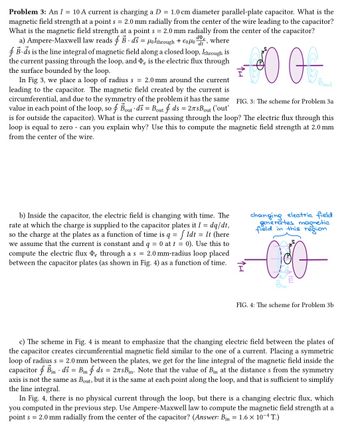Question
Hello, I really need help with all of these parts because I don't know where to begin. Is there any chance that you can help me with it and and can you label them as well

Transcribed Image Text:Problem 3: An I = 10 A current is charging a D = 1.0 cm diameter parallel-plate capacitor. What is the
magnetic field strength at a point s = 2.0 mm radially from the center of the wire leading to the capacitor?
What is the magnetic field strength at a point s = 2.0 mm radially from the center of the capacitor?
a) Ampere-Maxwell law reads f B. ds = Holthrough + €0μo
de, where
B-ds is the line integral of magnetic field along a closed loop, Ithrough is
the current passing through the loop, and De is the electric flux through
the surface bounded by the loop.
DO
In Fig 3, we place a loop of radius s = 2.0 mm around the current
leading to the capacitor. The magnetic field created by the current is
circumferential, and due to the symmetry of the problem it has the same
value in each point of the loop, so f Bout ds = Bout f ds = 27sBout ('out'
is for outside the capacitor). What is the current passing through the loop? The electric flux through this
loop is equal to zero - can you explain why? Use this to compute the magnetic field strength at 2.0 mm
from the center of the wire.
b) Inside the capacitor, the electric field is changing with time. The
rate at which the charge is supplied to the capacitor plates it I = dq/dt,
so the charge at the plates as a function of time is q = f Idt = It (here
we assume that the current is constant and q = 0 at t = 0). Use this to
compute the electric flux De through a s = 2.0 mm-radius loop placed
between the capacitor plates (as shown in Fig. 4) as a function of time.
Bout
FIG. 3: The scheme for Problem 3a
changing electric field
generates magnetic
field in this region
000
FIG. 4: The scheme for Problem 3b
c) The scheme in Fig. 4 is meant to emphasize that the changing electric field between the plates of
the capacitor creates circumferential magnetic field similar to the one of a current. Placing a symmetric
loop of radius s = 2.0 mm between the plates, we get for the line integral of the magnetic field inside the
capacitor Bin ds = Bin f ds = 27sBin. Note that the value of Bin at the distance s from the symmetry
axis is not the same as Bout, but it is the same at each point along the loop, and that is sufficient to simplify
the line integral.
In Fig. 4, there is no physical current through the loop, but there is a changing electric flux, which
you computed in the previous step. Use Ampere-Maxwell law to compute the magnetic field strength at a
point s = 2.0 mm radially from the center of the capacitor? (Answer: Bin = 1.6 × 10-4 T.)
Expert Solution
This question has been solved!
Explore an expertly crafted, step-by-step solution for a thorough understanding of key concepts.
Step by stepSolved in 4 steps

Knowledge Booster
Similar questions
- pls explain using your own wordsarrow_forwardplease type out or diagrams so that it is easy to readarrow_forwardFind an illustration or picture of the amusement park ride called the bumper ride, then proceed to add labels based on the guidelines provided within the image.PLS STOP REJECTING, I'M TIRED.arrow_forward
- For this problem, we want to estimate the answer, so our assumptions may be a little unrealistic. Suppose we want to estimate how much air we need to send to a space station, assuming we cannot recycle air. Suppose four astronauts are in a spherical space station. If each of them typically breathes about 500 cm³of air with each breathe, and take 15 breathes per minute (average resting value): a. What is the volume of air you would need in the space station if these four astronauts stayed for a full year? b. If the density of air is 1.25 kg/m³ and it costs (thanks to SpaceX) a mere $100/kg to send objects to the space station, how much money would the astronaut air supply cost?arrow_forwardHello, I really need help with Part A, PART B, AND PART C BECAUSE I don't understand it is there any chance you can help me with the problems and can you label them as wellarrow_forward© Reg=? O show the rimpl: ied Civcuit for euch steparrow_forward
arrow_back_ios
SEE MORE QUESTIONS
arrow_forward_ios